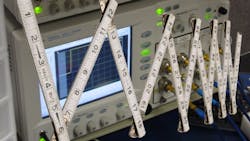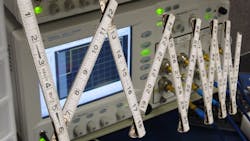Measuring the Need for Test Equipment
Test equipment and measurement methods have long been the cornerstones of RF/microwave electronic technologies, even though they are also often taken for granted as part of the design process. Put simply, “if you can’t measure it, you can’t understand it.” This has applied to this industry as it has evolved from designs based on vacuum tubes to the current evolution of semiconductors and integrated circuits (ICs) making increasing use of high-speed digital technologies and integral computers.
Developers of test equipment and new measurement techniques must keep pace when “breakthroughs” occur within RF/microwave technologies, such as the need to measure the performance of low-loss cryogenic circuits and devices or high-power-density gallium-nitride (GaN) transistors. Each new development in technology poses new measurement challenges and perhaps even a need to develop a new kind of test instrument. The steady evolution of wireless communications technologies, for example, encouraged test-equipment developers to evolve well beyond the traditional RF/microwave spectrum analyzer to the current generation of signal analyzers, with wide analysis bandwidths and the capabilities to capture and analyze signals with advanced digital modulation formats.
Microwaves & RF has tried over the years not to take for granted the efforts of test-equipment developers and the companies supplying different measurement equipment and solutions, and this blog will be devoted to that part of the industry. On a regular basis, this blog will report on new instruments and measurement approaches considered of benefit to the industry, in the various markets that this industry services, including for commercial, industrial, and defense-related applications. And, space and time permitting, this blog will look back at some of the instruments that have made their places in history (the HP 8510A/B vector network analyzer, anyone?), and how those instruments may have led to current-day technologies and test solutions.
Electronics test is experiencing a time of great growth and evolution, as more and more companies contribute test tools and instruments to the industry. Companies once considered only for their power transistors (and once known as TRW Semiconductor), such as Freescale, now offer an RF power measurement tool that helps simplify the development of power-amplifier circuits based on the firm’s transistors. And a company once associated mainly with its low-cost active and passive RF/microwave components, Mini-Circuits, now supplies low-cost signal generators among other RF/microwave test instruments. But these are just two examples of the ever-expanding supply base for high-frequency test instruments.
Measurement technologies are also changing at a rapid pace. Visiting a company once involved counting the number of 19-in. racks of test instruments, both in the research laboratories as well as on the production line. Whether for signal generation or analysis, these instruments occupied a great deal of floor space. The large physical sizes of the test gear also sometimes made it difficult to schedule time for a measurement when other groups and divisions within a company were awaiting measurement assignments.
With the influence of the PC, modern-day measurement systems are just as likely to fit on a desktop, in the firm of VXI or PXI instrument modules that slide into a mainframe rack. What once occupied several spaces within a 19-in. rack can now fit into a single PXI module, with signal-generation and signal-analysis functions fitting side by side within a single chassis on a desktop.
This blog is intended to report on the evolving world of electronic test and the many new instruments that are introduced on a regular basis. It will also review application notes and other educational tools that can help make measurements better and easier. Along the way, much thanks is due to the many engineers and their companies that make up the RF/microwave test and measurement industry and who have been extremely helpful in providing useful education on the practical use of their new instruments (and some not so new that required some additional education).
About the Author
Jack Browne Blog
Jack Browne, Technical Contributor, has worked in technical publishing for over 30 years. He managed the content and production of three technical journals while at the American Institute of Physics, including Medical Physics and the Journal of Vacuum Science & Technology. He has been a Publisher and Editor for Penton Media, started the firm’s Wireless Symposium & Exhibition trade show in 1993, and currently serves as Technical Contributor for that company's Microwaves & RF magazine. Browne, who holds a BS in Mathematics from City College of New York and BA degrees in English and Philosophy from Fordham University, is a member of the IEEE.

